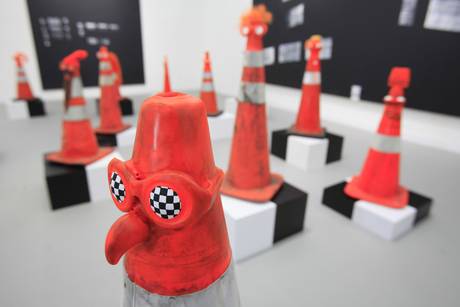You have no items in your cart. Want to get some nice things?
Go shopping
The sprawling Frieze Art Fair is the art world’s version of London Fashion Week; indeed, the Vogue UK website this week ran a gallery in which ultra-modish attendees modelled the height in luxury labels. The fair sees galleries from all over the world descend upon Regent’s Park for a one-week pop-up event based on gallery marketing and a quick boost to the art economy. With more than 150 galleries exhibiting, a few thousand visitors and not to mention the fringe events taking over the capital, Frieze, which The Guardian‘s Oliver Wainwright recently called a “four-day orgy of oligarchs”, is a monster fed by money – and giving little back.
Reports suggest an estimated $2bn worth of art being displayed at Frieze – and and the heavy hitters of the contemporary art scene are predictably in tow. Jeff Koons takes over the Gagosian Gallery stall with his kitsch stainless-steel sculptures: like him or not, they dominate the fair with their high-gloss colours, childish whimsy and abundance of security men. His playful take on the iconography of contemporary society helped rescue the potentially stuffy fair from any danger of stony-faced seriousness; indeed, there ran through this year’s fair a strong strain of spirited humour, ensuring that the giant bazaar would be an exuberant art world big-top. Similarly astronomically well-known, Damien Hirst displays at the White Cube, Sarah Lucas is at Sadie Coles, Elmgreen and Dragset are at Victoria Miro alongside Grayson Perry – there’s even a Warhol or two to see. But these mammoths of contemporary art feel incredibly predictable. That’s not to say they aren’t interesting artists with interesting work, just that the lack of innovation at this year’s Frieze is marked: you will have seen this all before.
However, without these big hitters Frieze would have very little to offer: there are many weak shows on display, making this year’s Frieze a decidedly mixed bag (presumably a Hermès or Chanel bag, to judge from Vogue‘s gallery). Underwhelming photography, uninspired oversized sculpture and awkward abstractions characterise the safe artworks that populate the market. Hours of walking, sore legs, stinging eyes and fatigue characterize the average punter’s Frieze experience, all in the name of an overly safe corporate melange. Fancy a break from the repetitive stalls? Your options include £13 for a half glass of champagne or perhaps some overpriced snack food. Put that on top of your £32 entry fee, and there is a genuine investment by the audience with no prospect of a return.
This is not to argue that the art economy is not a necessity for artists to survive, nor indeed that a collectors’ market is not an excellent tool to ensure art’s survival through the ages. However, without innovation there is little progression and when the money heads for safety during times of economic stress we, as an art community, cannot let artists coast like this.
So what are Frieze ’13’s highlights? Well, Rob Pruitt’s Safety Cones (After Richard Serra) (2013), displayed at Gavin Brown’s Enterprise, comprises comedic orange cones with caricature faces, a work that really highlights art’s ever-increasing juncture with comedy. These are on display immediately next to the entrance – meaning that, unfortunately, you have a lot more art left after viewing them. Turner Prize-nominated David Shrigley, however, steals the comedy crown with a lightbox declaring “Look at This” – underpinning what any art fair is really all about. My absolute favourite, however, is Djordje Ozbolt’s Made in Africa (Assembled in China) (2013), displayed at Herald Street Gallery. This unassuming group of brightly-coloured faux-African sculptures highlights through its clear design and concept the appropriation of images, pop culture and the capitalist economy. Unlike Frieze’s glittering behemoths, they are smart and witty and, crucially, it is easy to imagine owning them – what else can you ask from art-fair art?
The Frieze Art Fair is now finished.
About Ellen Stone
A freelance artswriter, critic and curator, Ellen also works as a Project Manager for the arts website kidsofdada.com. With a particular interest in contemporary art and art practices, Ellen has wrtten professionally about everything from European cinema to medieval book illustrations. Follow her on Twitter: @eestone1 or visit her blog: ellenelizabethstone.wordpress.com




